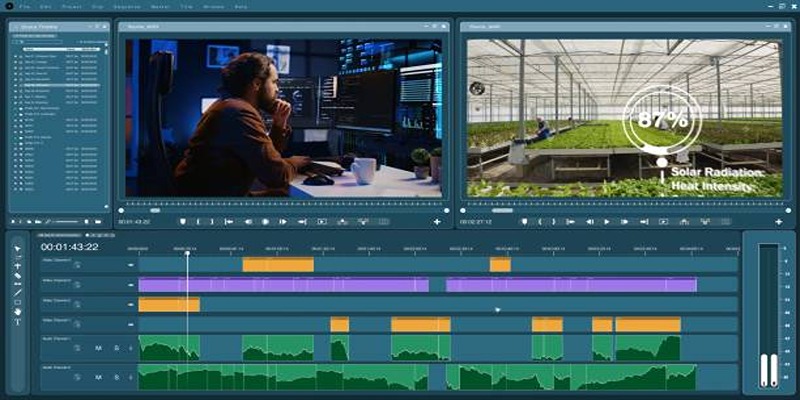Which Is Better for Compression? A Closer Look at H.264 and H.265
Advertisement
The digital video space has come a long way, with compression technologies evolving at a rapid pace. If you’ve heard of H.264 and H.265 but aren’t sure how they compare, you’re not alone. These two compression standards are commonly used in everything from streaming services to security cameras, but they each have unique advantages. This blog post will break down the differences between H.264 and H.265, examining their efficiency, quality, and applications.
What Are H.264 and H.265?

- H.264 (Advanced Video Coding or AVC) arose as a significant improvement over its predecessor, MPEG-2. It became widely adopted due to its balance of quality and efficiency, making it a staple for Blu-rays, television broadcasts, online streaming, and video conferencing.
- H.265 (High Efficiency Video Coding or HEVC) is the next evolution, designed to deliver better compression efficiency while maintaining or improving video quality. It was developed to address high-definition and 4K video content demands.
Compression Efficiency: How Do H.264 and H.265 Compare?
Compression efficiency dictates how well a video codec reduces file sizes while retaining quality. Simply put, the more efficient the compression, the smaller the file size you’ll get.
H.264 Compression Efficiency
H.264 uses macroblocks (16x16 pixels) as its foundation and applies predictive algorithms to encode data efficiently. While this approach was a major breakthrough in its time, it struggles to handle new demands, such as 4K content or higher motion details.
This is where H.264 starts to fall short. Modern streaming platforms that deliver Ultra HD, HDR, or immersive content generate large data streams. Encoding it with H.264 would require significantly higher bandwidth.
H.265 Compression Efficiency
H.265 takes compression efficiency to the next level. Instead of relying on macroblocks, it divides frames into coding tree units (CTUs), which can range from 4x4 to 64x64 pixels. This flexibility allows H.265 to preserve details while cutting video sizes drastically.
For example, H.265 can compress a video file to nearly half the size of an H.264 counterpart while maintaining equivalent quality. This makes it an excellent choice for 4K or even 8K video, where storage and bandwidth savings are critical.
Video Quality: Does One Stand Out?
Compression efficiency is important, but how do these codecs perform when it comes to video quality?
H.264 Video Quality
Although H.264 delivers good quality at modest bitrates, it does struggle with preserving details in high-resolution content. Its reliance on fixed macroblocks can make high-motion or high-detail scenes appear “blocky” under low bandwidth conditions.
H.265 Video Quality
H.265 excels here, too. Because it processes larger and more flexible CTUs, it can retain details such as sharp textures, vibrant colors, and smooth motion even at lower bitrates. This makes it ideal for premium content like high-definition movies, live sports, and immersive gaming.
However, the increase in quality comes at the cost of computational complexity, as encoding and decoding H.265 requires more processing power.
Performance in Streaming and Storage
When it comes to practical applications like streaming and video storage, the differences between H.264 and H.265 become even more apparent.
Streaming
H.264 has long been the go-to codec for streaming platforms like YouTube and Netflix. Its wide compatibility with existing devices ensures that videos play smoothly across various platforms. However, H.264 struggles with 4K and HDR, often requiring higher bitrates that strain internet speeds.
H.265, on the other hand, was made for modern streaming needs. It delivers HD and UHD content with significantly reduced bandwidth, which translates to smooth playback even for viewers with slower internet connections. The catch? Device support for H.265 needs to grow further, though many modern devices and browsers are now compatible.
Storage
For those dealing with video storage, H.265 offers noticeable benefits. Whether you’re managing a security camera system or an archive of UHD movies, H.265 can significantly reduce storage requirements while preserving video quality.
However, encoding these files requires more computational power, making H.264 a simpler choice in scenarios where hardware is limited.
Device Compatibility and Adoption

H.264 Compatibility
One of the reasons H.264 remains widespread is its exceptional device compatibility. From older smartphones and laptops to gaming consoles and broadcasting equipment, nearly every device supports this codec. This makes it the safer choice for universal compatibility.
H.265 Compatibility
Although H.265 adoption is growing, especially among newer devices capable of handling 4K and 8K content, it’s not as universal as H.264. Certain older devices may not support it, requiring workarounds like software decoding. This is something to bear in mind when sharing videos with diverse audiences.
Licensing and Costs
For businesses considering which codec to implement, costs associated with licensing can be a factor.
- H.264 Licensing is typically open and lower in cost, but fees are still imposed for certain use cases, such as distribution to a massive audience.
- H.265 Licensing incurs higher fees due to its advanced technology and potential for greater financial returns, particularly for commercial applications like broadcasting or streaming platforms.
Which One Is Right for You?
Ultimately, the choice between H.264 and H.265 depends on your specific use case and priorities:
- Choose H.264 if you need an established codec with broad compatibility, low hardware requirements, and decent performance for HD content.
- Choose H.265 if you want superior compression efficiency and video quality for 4K and beyond. It’s especially suitable if storage and bandwidth savings are crucial to your needs.
Final Thoughts
The debate over H.264 vs. H.265 partly boils down to old versus new. While H.264 offers reliability and simplicity, H.265 is a future-proof solution for modern video demands. It excels in high-resolution formats, offering a level of efficiency that H.264 simply cannot match. If you’re looking to adapt your video workflows for the future while optimizing storage and bandwidth, H.265 is the clear winner.
On this page
What Are H.264 and H.265? Compression Efficiency: How Do H.264 and H.265 Compare? H.264 Compression Efficiency H.265 Compression Efficiency Video Quality: Does One Stand Out? H.264 Video Quality H.265 Video Quality Performance in Streaming and Storage Streaming Storage Device Compatibility and Adoption H.264 Compatibility H.265 Compatibility Licensing and Costs Which One Is Right for You? Final ThoughtsAdvertisement
Related Articles

How to Create a Fake FaceTime Call to Prank Your Friends

The 8 Best Free Photo Editors in 2025 That Rival Photoshop

Top Free CRM Software in 2025 to Organize and Grow Your Business

How to Download and Add English Subtitles with Simple Steps

The 6 Best Jira Alternatives in 2025 to Streamline Your Workflow

Step-by-Step Guide to Making a Boomerang Video on Snapchat

What Makes Generative AI by Getty Images The Best AI Image Generator for Businesses?

Best DAV File Players to Watch Encrypted Videos on Your PC

Master the Art of Drawing on Videos with Step-by-Step Tutorials

The 6 Best Payment Processing Platforms in 2025 for Smooth, Secure Transactions

Top 5 Free Video Enhancers to Instantly Boost Video Quality

 novityinfo
novityinfo